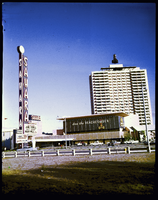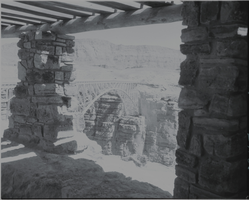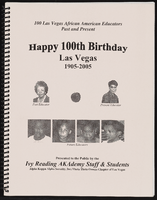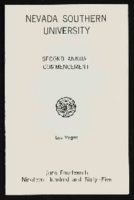Search the Special Collections and Archives Portal
Search Results
Florence Lee Jones and John Cahlan Papers
Identifier
Abstract
The Florence Lee Jones and John Cahlan Papers (1929-1983) contain material created by the couple related to their work at the
Archival Collection

The Sahara Hotel and Casino, don the Beachcomber Restaurant, and the marquee: photographic film
Date
Archival Collection
Description
Image

Film transparency of of the Navajo Bridge, Grand Canyon, Arizona, circa 1930s
Date
Archival Collection
Description
Image

"100 Las Vegas African American Educators Past and Present" booklet
Date
Archival Collection
Description
From the Alpha Kappa Alpha Sorority, Incorporated, Theta Theta Omega Chapter Records (MS-01014) -- Ivy Leaf magazines and event souvenir programs file. Full title of booklet: "100 Las Vegas African American Educators Past and Present. Happy 100th Birthday Las Vegas, 1905-2005. Presented to the Public by the Ivy Reading AKAdemy Staff & Students, Alpha Kappa Alpha Sorority, Inc./Theta Theta Omega Chapter of Las Vegas."
Text

Katherine A. Spilde Papers on Native American Gaming
Identifier
Abstract
The Katherine A. Spilde Papers on Native American Gaming include materials collected by anthropologist Katherine Spilde about Native American gaming and the greater gaming industry. The materials date from 1789 to 2015, with the bulk of materials dating from 1995 to 2010. Materials dating from the eighteenth and nineteenth centuries are reproductions of key court opinions and treaties concerning Native American rights and sovereignty. The majority of the materials document Native American gaming following the passage of the 1988 Indian Gaming Regulatory Act (IGRA). The papers detail Native American gaming enterprises both on and off reservations, the socioeconomic impact of gaming, and the legislative history of Native American gaming in the United States. The papers include research and subject files created by Dr. Spilde during her employment with the National Gambling Impact Study Commission (NGISC), the National Indian Gaming Association (NIGA), and the Harvard Project on American Indian Economic Development (HPAIED). The collection includes socioeconomic reports; testimonies; correspondence; memos; press releases; photographs; audiovisual materials; promotional materials from casinos and tourist attractions; brochures; fact sheets; summaries; booklets; pamphlets; advertisements; tourism materials; journal articles; legal briefs; legislative documents; court opinions; Dr. Spilde’s notes; presentations; packets, agenda, schedules, and itineraries from conferences; periodicals; Native American and community newspapers; and newspaper articles. The collection includes materials about over one hundred federally recognized Native American nations. Also included are materials that document the socioeconomic impact of gaming, the international gaming industry, criminal activities related to gaming, advertising about gaming and casinos, lotteries, internet gaming, compulsive gambling, and bankruptcy as a result of gambling.
Archival Collection

Nevada Southern University 2nd commencement program
Date
Archival Collection
Description
Commencement program from University of Nevada, Las Vegas Commencement Programs and Graduation Lists (UA-00115).
Text
Center Stage, Inc. Records
Identifier
Abstract
The Center Stage, Inc. Records (1994 to 2008) are comprised of photographs, bylaws, correspondence, meeting minutes, publicity, scripts, programs, cast lists, and video cassettes of a number of the productions. Center Stage Theater Inc. was the first LGBT theater company in Las Vegas, Nevada.
Archival Collection
Nevada Official Bicentennial Book Collection
Identifier
Abstract
The Nevada Official Bicentennial Book Collection (1975) contains materials related to the editing and publication of the book by the Nevada American Revolution Bicentennial Committee. It includes article submissions about Nevada history as well as a small amount of correspondence to Stanley Paher, the editor of the book.
Archival Collection
Paul May Papers
Identifier
Abstract
The Paul May Papers (1963-1984) contain correspondence, reports and minutes from the Nevada Legislature, campaign materials, and invitations to various events.
Archival Collection
